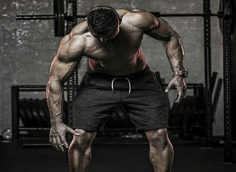Building big, healthy shoulders goes beyond just overhead pressing a city bus. Sure, that'll get the job done if you're capable of it, but there's a better way. We'll get into some of the exercises you probably aren't doing, but there's something we have to talk about first...
There's a handful of reasons you might find it difficult to develop a stubborn body part. Lack of mind-muscle connection, poor execution, poor movement selection for your structure, and poor overall programming are a few.
The old bodybuilding adage, "train a muscle at different angles," was basically a way of saying that you need to take advantage of the length-tension relationship within different movements. Different exercises will provide different resistance curves to the muscles being trained, so they'll train those muscles at different lengths within the movement. Maximizing development is about creating as much tension as possible in those different lengths.
The key is to find exercises that best suit your structure and best train the muscles in various positions: lengthened, mid, and shortened. But it's also important to use movements that stress the targeted musculature appropriate within those lengths.
Here are four exercises that'll satisfy this approach:
The dumbbell overhead press is a proven delt strength and size builder. But both strength and physique-focused lifters could be doing it more effectively.
The most common way people do the press is seated (which is fine), then they lock the elbows back by using external rotation, and press from the shoulders to the overhead position with the dumbbells arching together over that range of motion.
There are a few problems here. To start, you can't get away from the fact that this exercise predominantly hits the anterior delts. This means you should be making sure to get the anterior delt loaded maximally in its most lengthened state. Doing this will keep you from going into excessive external rotation and instead let the elbows come forward a bit, allowing you to work in your natural scapular plane.
While pressing, you want to avoid that common arching motion because it actually takes the delts out of their active range of motion very quickly. It's the traps that adduct the arms in that overhead arching motion.
This arching motion also shortens the lever arm in the movement, making it easier as you reach lockout. And that's cool and all if you aren't trying to stress the actual delt muscles. But if you are, it means you're not spending as much time in the area where the movement is actually difficult.
The better way to perform these is to press directly upwards with the dumbbells staying in line with the elbows. It's no different than if you stacked the elbows and wrists in a vertical line with one another like if you were doing a barbell press.
Lastly, to make these more productive, add a band to flatten out that descending resistance curve. By adding in the band we're eliminating that dead area in the range of motion at the top and creating a longer torque curve.
Now you're maximally loading the anterior deltoid in the bottom, you're staying in a longer active range of motion, and you're eliminating that dead range of motion near the top where there's very little tension.
I've done my fair share of bent-over lateral raises (rear delt raises), but the truth is that they fall short as a rear delt movement.
With a bent-over lateral raise, the rear delts never actually get fully shortened. A key component in maximizing an exercise is to get the target muscle fully lengthened and then fully shortened within a movement. But some exercises don't do that as well as others.
A better option is the rear delt row with supination. With this exercise, you'll be rowing (as you might expect) to bring the elbow behind the body as far as possible, which will shorten the rear delt. But you'll add a twist, literally, by supinating as you perform the row.
Why the twist? Because it'll bring about a certain amount of external rotation in the shoulder, which is one of the components of the rear delt. Supination at the forearm is actively linked with external rotation of the shoulder, just like pronation is linked with internal rotation.
This isn't an exercise you'll go super heavy on, but you won't need to so long as you're using the appropriate resistance with it for the mechanics, and making sure to get the rear delt fully shortened.
It's nearly impossible to cheat with these, unlike the standing lateral raise. Not that cheating is bad, and I actually do add cheaty lateral raises into my programming from time to time. But for most guys having trouble getting a strong mind-muscle connection, the incline version is a better choice.
This exercise will also naturally put the resistance in line with the middle fibers of the delt. When you use a standing lateral raise it's common (and fairly natural) to work more in the scapular plane, which is slightly safer for the shoulder joint. But it also tends to make it more of an anterior deltoid movement, which we're trying to avoid since that's already been covered.
Since the resistance is more in line with the middle delt, and you can't cheat, you'll naturally bring the dumbbells directly up to your side. This is what makes it a great option for smoking the middle delts.
Lastly, if you want to keep tension on the shoulders as much as possible throughout the range of motion, then eliminate the bottom quarter of the movement. The delt itself isn't very active in the bottom part of the range of motion. It's the supraspinatus that initiates the abduction of the arm from this position, and then the delt takes over after that.
Once you lift the dumbbells to the top on the first rep, lower only about three-fourths of the way down before doing the next rep.
Try these with drop sets or cluster sets. Do 4-6 sets total in the cluster with 10 seconds between each set, going to total muscular failure on the last mini-set.
You can do this lift with an incline bench or standing. You'll be using cables, which means you'll end up with a different resistance curve than you do with dumbbells.
With dumbbells, you're working with an ascending resistance curve and a descending strength curve. So the weight feels the heaviest when you're in the weakest mechanical position. This is because gravity is working against you while the resistance is at the furthermost point from the main working joint.
But with cables, the exercise will be harder at the start where you're strongest, then taper off at the end range where you're weakest. This is much more ideal for this exercise, especially if you're doing the incline lateral raises before these or even after. You'll be working the muscle at different lengths despite the motion being similar.
With the Y-raise you're bringing the arms up at a 45-degree angle relative to your torso. This will not only fully shorten the middle delt, but will also bring in the lower traps in. You need strong lower traps to have good shoulder girdle stabilization. Better joint stability means better output for the working muscles.
Stop locking your shoulders back and down. When doing lateral raise variations, or any of these movements that raise the humerus, you don't want to lock your scapula down (go into retraction or depression) before doing them.
I see this advised a lot and it's cringe worthy. The traps and the rhomboids are used to provide stability to the scapula during lateral raises. By locking the scapula down into retraction and depression you take away their ability to do this and provide superior stability to the joint.
With lateral raises, the scapula actually need normal and authentic upwards rotation. When you intentionally inhibit that, you actually create less stability in the joint and crappy motor patterns for that movement. When you do this, you end up getting less output from the working muscles and set yourself up for shoulder problems down the line.
To keep this simple, don't initiate the movement with the traps, but don't lock them down either. It's a lateral raise. That just means raising your arms out to the side. You don't need to "lock things down" to do this effectively.
Guys struggling to build bigger shoulders try to grow by doing tons of heavy overhead presses without taking into account that they aren't training the delts much differently than they train their heavy chest pressing. (The delts are heavily involved in chest pressing).
If your delts are a lagging muscle group, and you've been doing heavy overhead pressing, then it should dawn on you that perhaps training each head of the deltoid more directly is in order. Make sure you're directing as much tension as possible toward the areas of the delt you're trying to work.
Don't sacrifice form for loading initially. Once you have the execution down, then focus on the loading progression. This is the smart approach.




